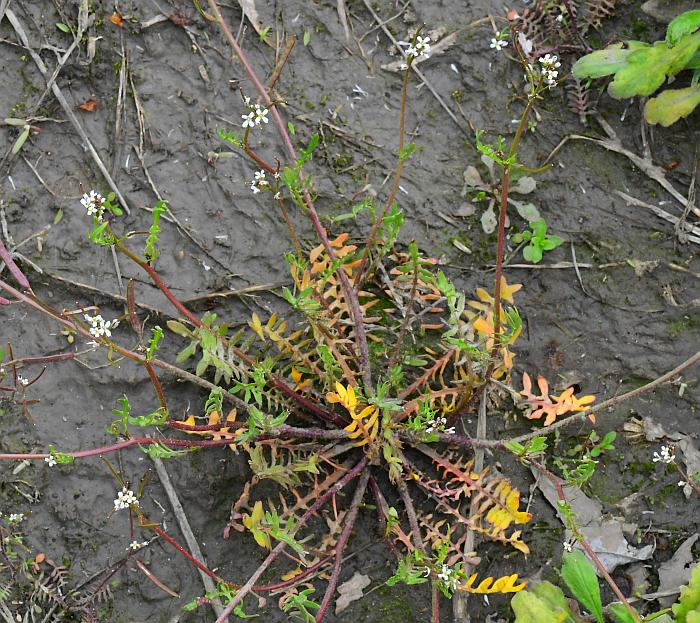Planodes virginicum (L.) Greene
Virginia Rock Cress

Native
CC = 0
CW = 3
MOC = 75
© SRTurner
Planodes virginicum (L.) GreeneVirginia Rock Cress | |
 |
Native CC = 0 CW = 3 MOC = 75 |
© SRTurner |
|
Family - Brassicaceae Habit - Taprooted annual forb. Stems - Ascending to erect, to 40 cm, single or multiple, mostly glabrous above, pubescent with mostly unbranched hairs near the base, often reddish in strong sun, sometimes branching in the upper half.
Leaves - Basal and alternate, pinnately divided. Basal leaves petiolate, not clasping the stem, the petiole and rachis pubescent, the blades oblong in outline, 2-8 cm long, pinnately divided into 5-21 narrow, entire or few-toothed lobes, those of the stems similar but gradually reduced in size and number of lobes, mostly glabrous. Leaves overwintering as a basal rosette.
Inflorescence - Terminal and axillary racemes, compact in flower, quickly expanding in fruit to more than 2/3 of the total plant height. Bracts absent. Pedicels short (1-3 mm) in flower, elongating to 4 mm in fruit, glabrous.
Flowers - Sepals 4, 1.2-1.5 mm long, narrowly oblong-elliptic, erect, usually purple-tinged. Petals 4, 2-3 mm long, not lobed, white, distinct, rounded at the apex, glabrous. Stamens 6, erect. Ovary cylindric, green to purple, glabrous, 1-2 mm long in flower. Styles 0.2-0.5 mm long.
Fruits - Siliques 15-25 mm long, ascending, straight, flattened parallel to the septum, the valves extending to the margins, the replum not winged, dehiscing longitudinally, the valves breaking off without coiling and each with a faint midnerve near the base. Seeds in 1 row in each locule, 1.1-1.5 mm long, broadly elliptic to nearly circular in outline, somewhat flattened, the margins winged, the surface with a netlike or honeycomb-like pattern of ridges and pits, reddish orange.
Flowering - March - May. Habitat - Streambanks, moist pastures, fields, roadsides, and open, disturbed areas. Origin - Native to the U.S. Lookalikes - Small species of Cardamine, especially C. hirsuta, C. parviflora, and C. pensylvanica. Other info. - This small springtime mustard is found throughout most of Missouri, less commonly in northern counties. Its range in the continental U.S. is mainly within the southeastern quadrant of the country, though it is also found as an introduced species in California. It closely resembles related plants in the Cardamine genus, but can be distinguished by its broader, flatter fruits (best seen in older, more mature fruits) and winged seeds. The overwintering basal rosettes also form a distinctive flattened, radial array of sharply pinnate leaves. Photographs taken off College Ave., Columbia, MO., 4-1-04 (DETenaglia); also at Weldon Spring Conservation Area, St. Charles County, MO, 3-15-2016, Pacific Palisades Conservation Area, Jefferson County, MO, 4-2-2020, and Young Conservation Area, Jefferson County, MO, 3-30-2021 (SRTurner). |